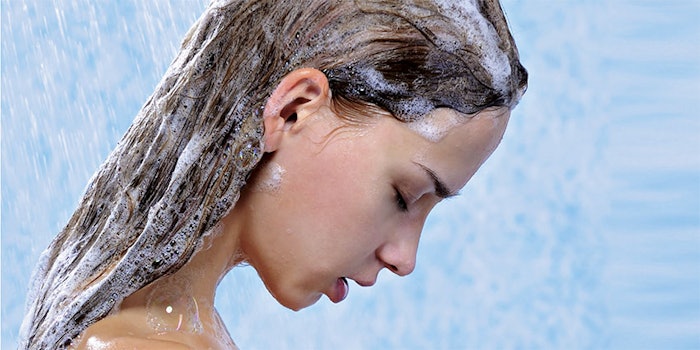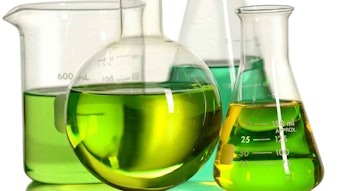
Perfume is an important product attribute that differentiates a given personal cleansing product from others in a crowded market. However, it remains technically challenging to incorporate high percentages of fragrance oil (≥ 2%) into shampoo or shower gel formulations without adverse effects on clarity, target viscosity and foaming, as will be explained.
This technical challenge has become more significant, especially as the market continues to move toward skin-friendly cleansing formulations using non-sulfate surfactants such as alpha olefin sulfonate (AOS), and mild amino-acid based surfactants such as sodium cocoyl glutamate. This article describes approaches to build viscosity in cleansing formulas and presents a new concept based on a multi-arm, nonionic associative thickening polymer.
Viscosity Basics
All surfactants are composed of a hydrophilic head and a hydrophobic tail. When the ratio of head area/tail area is > 3, the geometric packing of surfactants in water favors a small spherical micelle structure, which leads to a low viscosity. When this ratio is between 3 and 2, the curvature of surfactant structures is reduced, leading to the formation of a rod micellar structure, which creates viscosity. In essence, larger rod micelles equal higher viscosity (see Figure 1).
The hydrophobic tails of all surfactants and hydrophobic thickeners are composed of a C8-C14 alkane chain, which precludes any significant modifications. Thus, the ideal location to influence and manage surfactant packing geometry is at the hydrophilic head group. Figure 1 illustrates the classical approach to thickening a surfactant cleansing formulation by transforming the surfactant micellar structure from small spherical micelles to elongated rod micelles using salt, co-surfactants and hydrophobic nonionic surfactant thickeners. All three strategies reduce the curvature of the micelle structure by decreasing head group areas.
Salt: Owing to charge-charge repulsion in water, the head groups of primary anionic surfactants have an effective head group area larger than their actual physical area. Incorporation of salt into formulations reduces charge-charge repulsion and practically reduces the effective area of the surfactant head group.
Co-surfactants: Co-surfactants, such as cocamidopropyl betaine, have a smaller effective head group area due to their amphoteric nature. When co-surfactants are blended with primary surfactants and positioned between two anionic primary surfactant molecules, they reduce the overall head group area, leading to the formation of rod micelle structures.
Hydrophobic nonionic thickeners: Lastly, hydrophobic nonionic surfactant thickeners generally possess a low molecular weight with a small head group and efficiently induce the formation of large ordered micelle structures, such as a rod micelle or a large lamellar liquid crystal structure, with high shear thinning viscosity. Common thickeners include glyceryl caprylate/caprate, glyceryl monolaurate, cocamide MIPA, cocamide DIPA and isostearic acid.
Additives, Viscosity and Clarity
Shampoos, shower gels and other personal cleansing products face a commercial reality: they must contain perfume oil, extracts, actives, preservatives, chelators, etc., to differentiate brands and appease target consumers. However, the viscosity and clarity of personal cleansers are sensitive to the relative concentrations of almost every component in a formulation, one being perfume oil.
The ideal location to influence and manage surfactant packing geometry is at the hydrophilic head group.
For example, modern, sulfate-free surfactant formulas with the desired clear appearance and high perfume content generally comprise a mix of small and short, rod and spherical micelles; as such, the trade-off tends to be low viscosity. Indeed, the inclusion of most any additives such as salt or alcohol can interrupt the packing of surfactant molecules in water, resulting in lower viscosity.
Additives also can change the size, shape, density and water solubility of surfactant micellar structures, and any changes that decrease the water solubility of any component may change the refractive index of the system, causing opacity. As another example, to maintain shampoo clarity, perfume oil molecules must exist as microemulsions or be packed inside of surfactant micellar structures and/or perfume solubilizers. Otherwise, they form aggregates, particles or phases that are not soluble in water and are large enough to diffract light. Thus, any changes that decrease the capacity of micelles to carry perfume molecules would force those molecules out, where they would separate as aggregates or droplets and cause opacity.
Even the incorporation of additives to increase viscosity or improve clarity can have unintended consequences, as shown in Figure 2. Here, note the colors of the bars correlate with clarity, as determined by visual assessment. This cleansing formulation contains 17.5% surfactant actives comprising 20% SLES (70%), 10% cocamidopropyl betaine and 0.1% EDTA at a pH of 5.5.
Salt, which is used to increase viscosity, causes the formulation to become opaque with or without 3% perfume. Why? Because although salt increases the size of the surfactant micelles, favorably increasing viscosity, it also decreases water solubility and this combination can increase light diffraction, causing opacity.
Alternatively, the addition of 4% glyceryl caprylate/caprate (GCC), a hydrophobic thickener, effectively increases the viscosity while maintaining desirable clarity. However, the formulation again becomes opaque with the addition of 3% perfume. Why? Because this thickener favorably changes surfactant packing in terms of viscosity, but this packing does not support the incorporation of perfume molecules. Thus, when 3% perfume is added, the micelles cannot carry it and some perfume molecules separate out as large aggregates, causing opacity.
One classical approach to enhancing clarity is incorporating a perfume solubilizer. Perfume solubilizers work by forming micellar solutions with perfume molecules. There are many types of perfume solubilizers and some work better than others with given perfumes and systems. For example, as shown in Figure 2, while the addition of 3% PEG-40 hydrogenated castor oil was ineffective, the addition of 3% polysorbate 80 improved clarity; then again, it significantly decreased viscosity.
In summary, many of the common core components in surfactant formulations—including salt, perfume, hydrophobic thickener, perfume oils and perfume solubilizers—can produce unexpected negative effects on clarity and viscosity above certain concentration thresholds. This example of an SLES surfactant formulation, in Figure 2, illustrates the technical challenges many formulators face when developing commercial shampoos or shower gels with desired clarity and viscosity.
When the surfactants are non-sulfate surfactants, however, the technical challenges become more significant. For example, Figure 3 shows molecular models of SLES and amino-based sulfate-free surfactants and their likely micellar structures and sizes. The hydrophilic head groups of the glycinate and glutamate surfactants are larger than that of SLES surfactants (see Figure 3a). Hence, they are more difficult to formulate into long, rod micellar structures to achieve desired viscosity levels (see Figure 3b) since the resulting micellar structures will be smaller and more numerous.
Additives such as salt, perfume oils and thickeners can negatively affect solubility and surfactant packing.
Nonionic Associative Thickening
Another approach to thickening surfactant formulations is using nonionic associated thickeners. They work by bridging surfactant micelles with hydrophobic fatty groups, resulting in a micellar network structure that is much larger than the original micelles—without affecting the original surfactant micelle packing. Larger, bridged micellar structures result in higher viscosities. Overall, the number of arms a nonionic associative thickener has is directly correlated with the efficiency with which it can build viscosity in surfactant formulations. This concept is illustrated in Figure 4.
PEG-150 distearate, for example, possesses two arms and two hydrophobic groups and can bridge two surfactant micelles. This leads to a small, bridged micellar structure with a modest increase in viscosity. Therefore, its effects are limited and even ineffective in surfactant formulations having large numbers of small micellar structures, such as a non-sulfate surfactant formulas or sulfate surfactant formulas with many additives.
Other nonionic associative thickeners have been developed with three and four arms, capped with fatty acids such as stearic and oleic. Examples include PEG-200 hydrogented glyceryl palmate with three arms; and PEG-150 pentarythrityl tetrastearate and PEG-120 methyl glucose trioleate with four arms.
More recently, a six-armed sorbeth-230 tetraoleatea was developed from natural sorbitol and ethylene oxide (see Figure 5). Subsequent reactions with naturally sourced oleic acid form four hydrophobic interaction oleic groups at the end of the arms, and these six hydrophilic arms and four hydrophobic groups can thicken sulfate-free surfactant formulas by bridging across much larger micellar structures. Hence, this star-shaped polymer can build viscosity efficiently in all surfactant formulations.
Viscosity Comparison
A comparison of the viscosity of the same cleansing formulation used in Figure 2—i.e., 20% SLES (70%), 10% cocamidopropyl betaine and 0.1% EDTA at pH 5.5—and using commercial thickeners having different numbers of arms is shown in Figure 6. Thickeners ranged from two arms: PEG-150 distearate; and three arms: PEG-200 hydrogenated glyceryl palmate (and) PEG-7 glyceryl gocoate; to four arms: PEG-150 pentaerythrityl tetrastearate (and) PEG-6 caprylic/capric glycerides (and) water (aqua); and six arms: sorbeth-230 tetraoleate (and) decyl glucoside (and) sorbitan laurate. While all formulations were clear, the six armed-polymer proved to be the most efficient thickener.
Conclusions
Building viscosity and clarity in surfactant systems, especially those that are sulfate-free and have high fragrance loads, is an important technical challenge in today’s personal care product space. In response, a new six-arm nonionic associative thickener was developed that effectively bridges many small micelles in surfactant systems to create larger, bridged micellar structures, ultimately improving viscosity and retaining clarity. Formula 1 demonstrates three shampoos utilizing this thickener with three surfactants: SLES, AOS and glutamate, which remain clear with 3% perfume oil. This technology not only answers a formulation challenge in the industry, but can empower formulators to create beyond traditional constraints.











